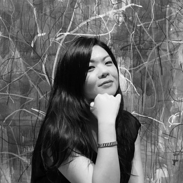On View
How Rijksmuseum’s Dazzling Asian Bronze Show Rethinks Art History
From hidden scrolls to secret mirrors, this extensive exhibition brings together bronze works from across Asia that span 4,000 years.
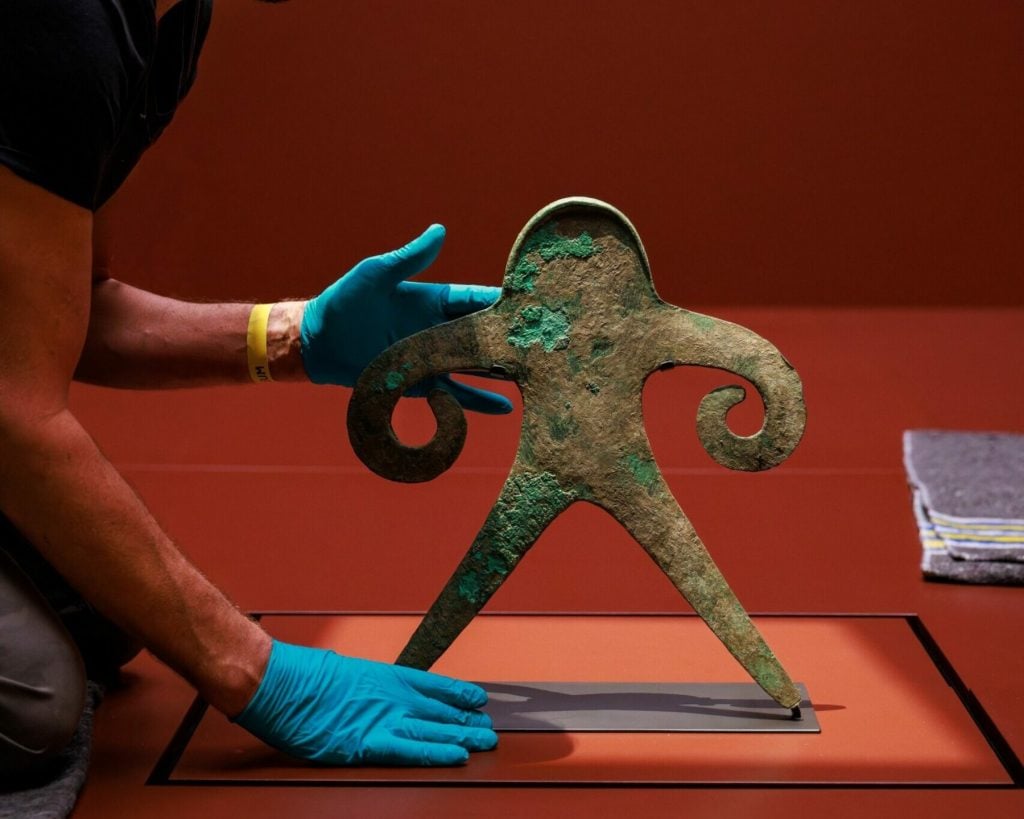
A 4,000-year-old tiny figurine that bears the silhouette of an elegant woman, a wine vessel in the form of a baby elephant from the 18th to 11th century B.C., and a sculpture of a mother breast-feeding an infant from the 12th century, what do they have in common besides the fact that they are ancient?
These wonders of the world are all made of bronze and hail from different parts of Asia. Thanks to Amsterdam’s Rijksmuseum, over 70 works are gathered together as part of “Asian Bronze: 4,000 years of beauty.” The expansive exhibition features works from India, China, Indonesia, Japan, Thailand, Vietnam, Pakistan, Nepal, and Korea, many of which left home and are being exhibited abroad for the first time, as well as objects from the Dutch museum’s own collection.
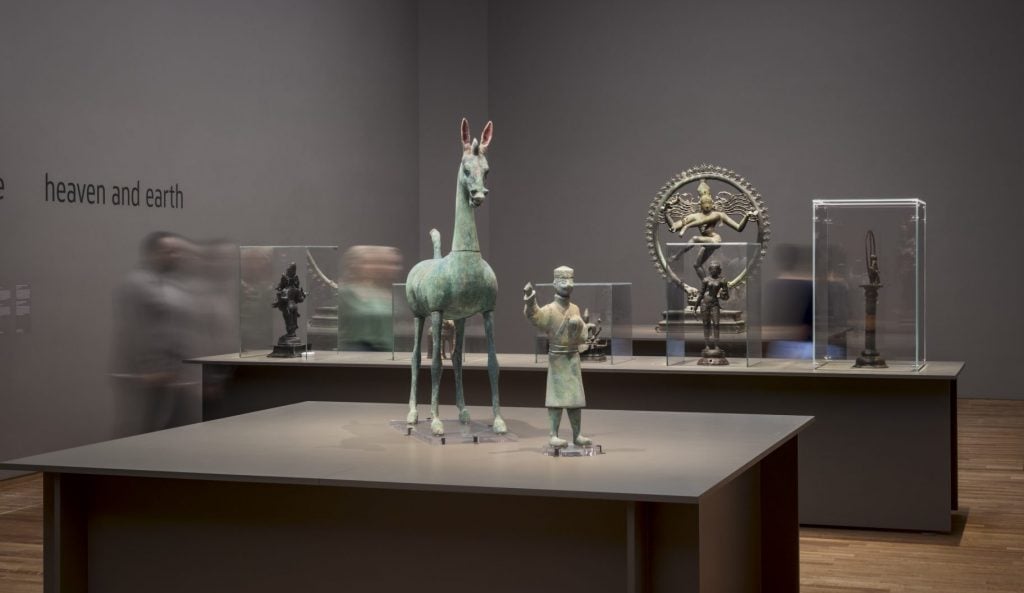
Installation view of “Asian Bronze”. Photo: Rijksmuseum/Erik and Petra Hesmerg
In Western institutions, ancient bronzes have often been shown as ethnographic objects. But the Rijksmuseum’s show positions them as part of art history and charts the trajectory of humanity’s eternal desire to tell stories from prehistoric days to contemporary times. The subject matter and aesthetics vary, the techniques and use of materials evolve, but the aspiration for beauty, harmony, and transcendence beyond the mortal realm is the same. Here, bronze is like canvas, and various casting techniques adopted by different cultures and makers in different periods are like brushes and colors.

Installation of Buddha Seated Under the Hood of a Seven-Headed Nāga, Thailand, 12th–13th century. Photo: Rijksmuseum/Kelly Schenk
“The beauty and breathtaking techniques, the differences and similarities, the unrivaled skills of their creators, bronze connects Asia and makers of contemporary and ancient times,” said Menno Fitski, head of Asian art at Rijksmueum. “People have been standing in front of these sculptures for centuries with their own private emotions. This makes them more than just a piece of metal.”
The result of meticulous research led by the museum’s exhibition team—including curators Anna A. Ślączka, Ching-Ling Wang, and William Southworth, as well as Sara Creange, the museum’s metals conservator—the show is organized by several thematic sections to tell the Asian bronze story in a more holistic way than chronologically or regionally.
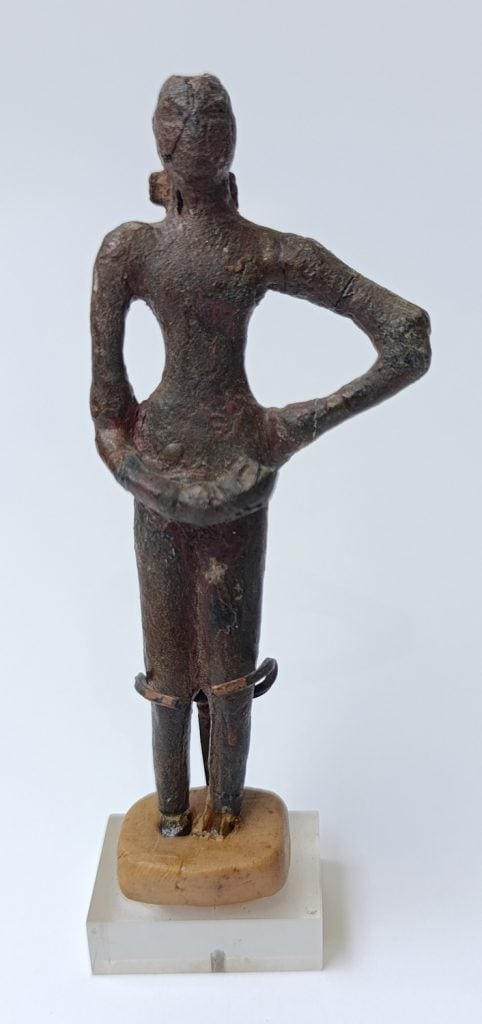
Standing female, a figure from Mohenjodaro, Sindh province, Pakistan, circa 2500 to 1500 BCE. on loan from the National Museum of Pakistan in Karachi. Courtesy of Rijksmuseum.
The technique of creating bronze from an alloy of copper and tin was discovered in Asia, which is where the exhibition’s “Materials and Beginnings” section starts. The most fascinating work here is Standing female, a figure from Mohenjodaro, Sindh province, Pakistan, on loan from the National Museum of Pakistan in Karachi. Measuring only five inches tall, the work is dated to 2500 to 1500 BCE and is the oldest object on display. When it was created, bronze craftsmanship was still in its early stages, and very little is known about it.
Yet its depiction of an elegant female figure, standing upright with one hand on her hip and the other posing as if she were carrying something, makes a lasting impression. It raises questions about the perception and status of women in ancient times. For similar reasons, the anthropomorphic figure from India’s Ganges Valley (circa 1500 to 1000 BCE), on loan from Musée départmental des Arts Asiatiques in Nice, is equally fascinating.
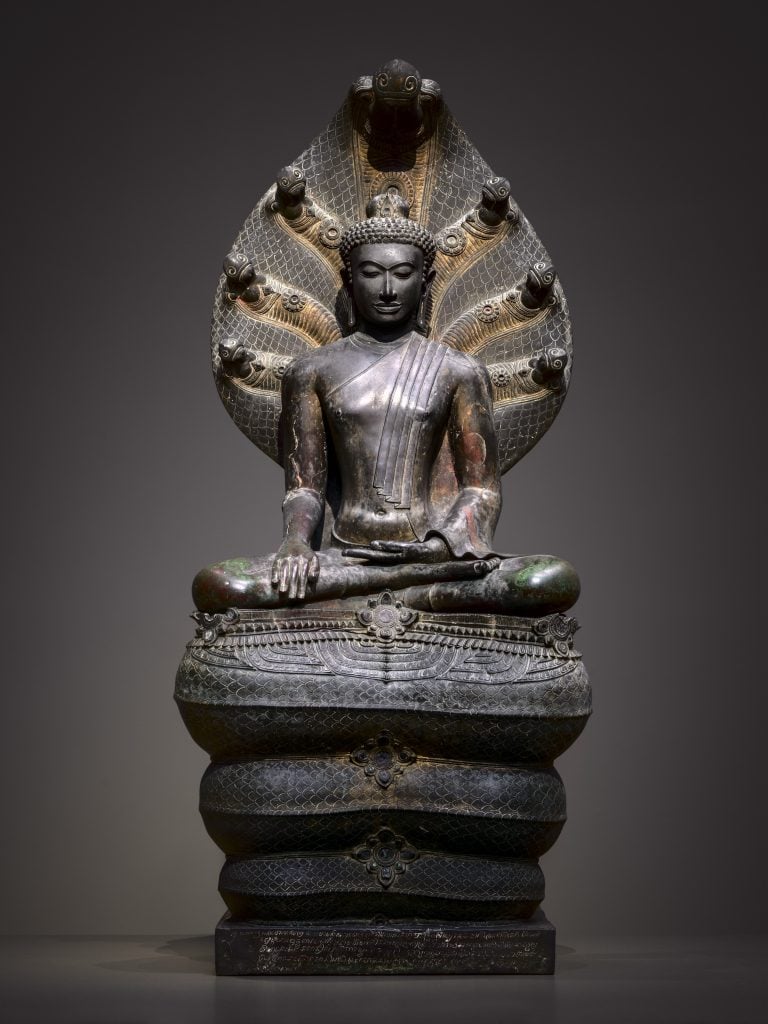
Buddha under Naga’s hood, Thailand, 12th-13th century. National Museum, Bangkok
Photo: Rijksmuseum/Erik and Petra Hesmerg
The two-part Heaven and Earth section makes up a significant portion of the show as a lot of bronze objects tended to be made with a religious or spiritual intention. Ślączka explains in her catalogue essay that bronze was broadly used across the region especially Hinduism and Buddhism because these bronze works, which represent the images of deities and sacred characters, must be strong enough to withstand the worship rituals, as these rituals ranged from offerings of food to bathing and anointing. “Wood and clay, do not last well in the hot and humid climate that characterizes many parts of Asia,” she noted.
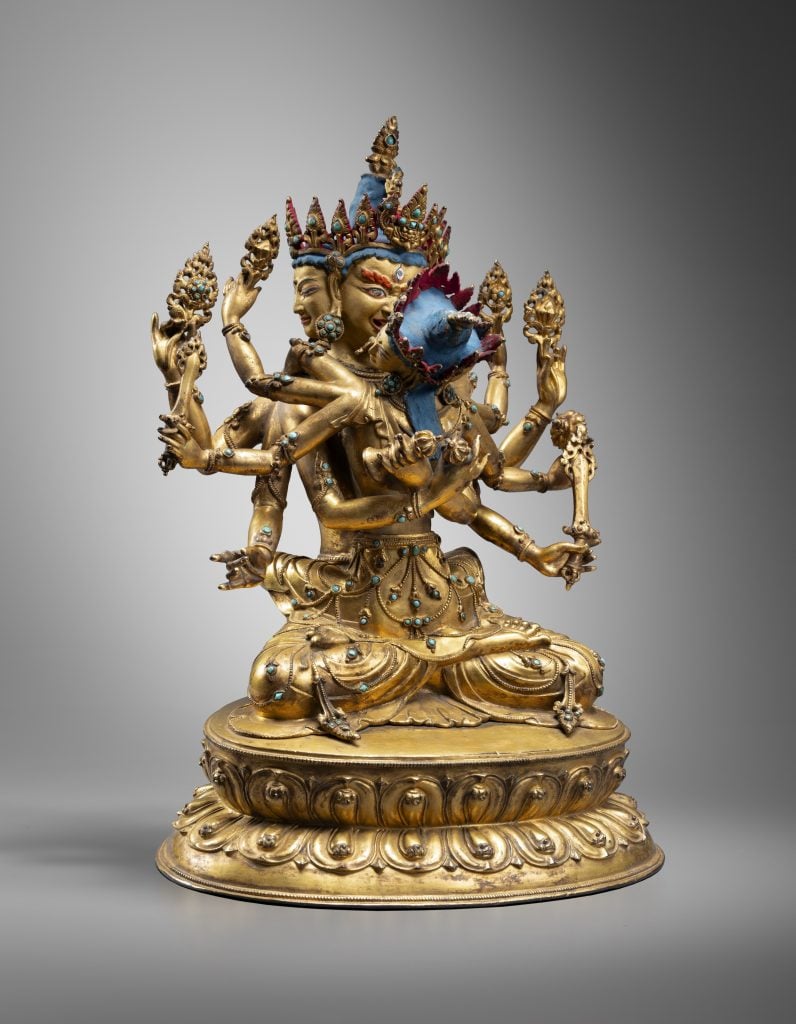
Guhyasamaja Aksobhya, Tibet, 15th century. Rijksmuseum, Amsterdam.
The works on view in this section showcase the remarkable skill and craftsmanship that artisans possessed centuries ago. The more than five-foot-tall statue of the Buddha seated under the hood of a seven-headed naga from 12th to 13th century Thailand is one example. On loan from National Museum in Bangkok, the highly polished work not only tells a famous story about the Buddha, its design carries aesthetic elements from beyond Thailand, such as China, Cambodia, and India.
A Tibetan Guhyasamaja Akshobhya from the first half of the 15th century is one of the highlights of the show. It offers a vivid three-dimensional depiction of the iconic personality of Tantric Buddhism. Kept in the Rijksmuseum’s collection, the enthralling gold-gilded sculpture symbolizes the unity of opposite forces and a higher state of enlightenment. Ten years ago, researchers at the museum realized it was cast from solid bronze—a technique that Europeans artisans had not yet mastered. This discovery prompted the curatorial team to question what they knew about Asian bronzes and ultimately led to this exhibition.
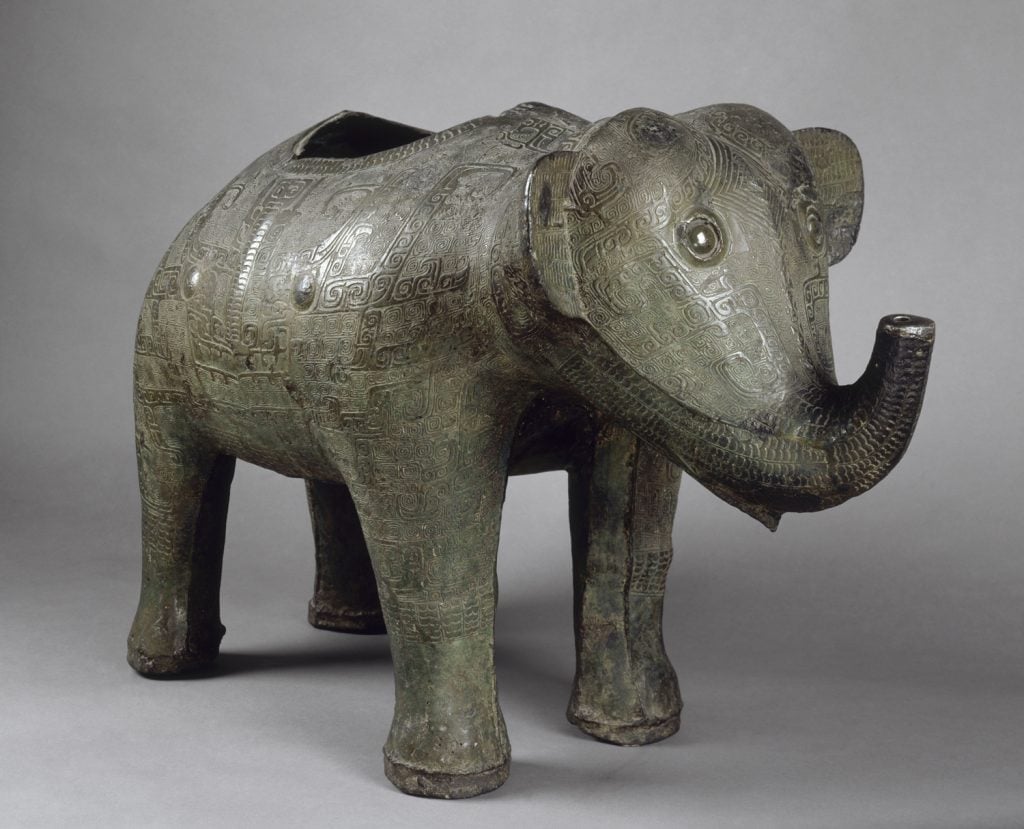
Wine vessel in the form of an elephant, China, 18th –11th century BC. Musée Guimet, Paris.
Ślączka noted that further scans of the work revealed that the statue contained a scroll hidden inside. What the scroll says remains a mystery as the museum did not want to extract it to avoid damaging the work.
Bronze was also used to create weapons, tools, utensils, and containers for food and drink, many of which are featured in other parts of the exhibition. A standout piece is a wine vessel shaped like a baby elephant, dating back to 12th to 11th century BCE China. Its charming depiction resembles modern toy store designs, but as Wang pointed out, it also reveals the Chinese invention of using clay molds to cast intricate abstract patterns on the vessel’s surface.
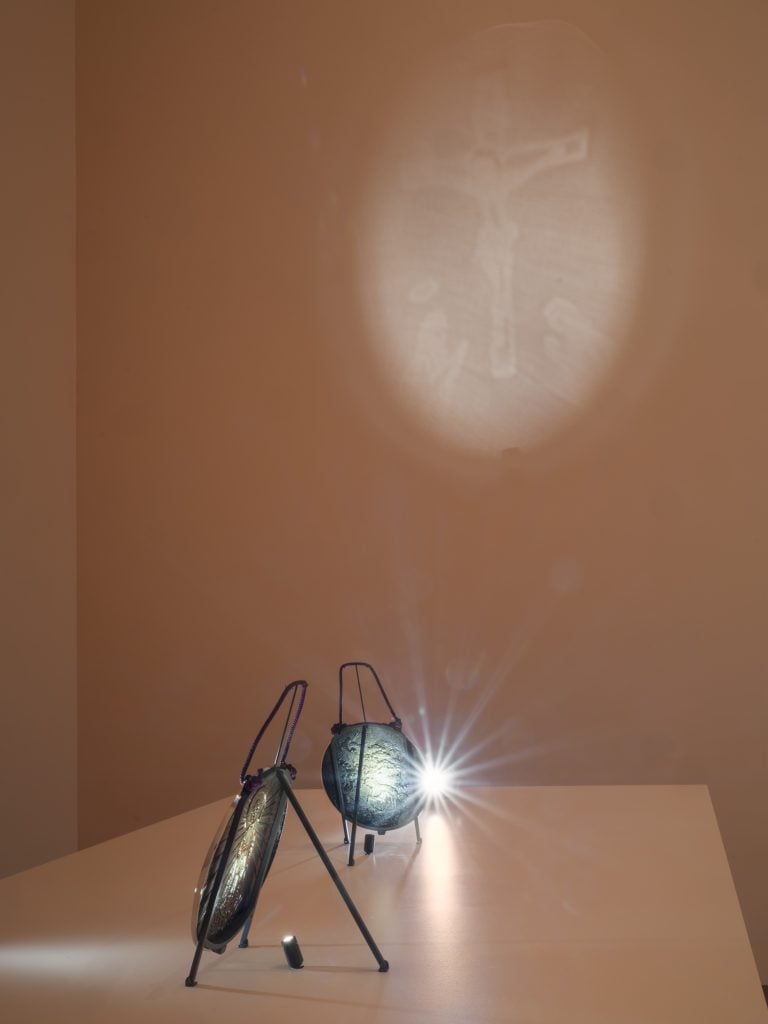
Magic mirrors by Yamamoto Akihisa. Photo: Rijksmuseum/Erik and Petra Hesmerg
The exhibition concludes with a display of mirrors set in bronze, including two works by a contemporary Kyoto craftsman, Yamamoto Akihisa, who has carried on the ancient Japanese tradition of “secret mirrors,” which were mystical objects used to project a hidden image only when light hits them at the right angle. These works were originally created in the 17th century, at a time when Christianity was forbidden by the shogunate; many contained images of the crucifix and the Virgin Mary, as well as depictions of Buddha and tree scenery.
“The Asian world is not just one thing,” said Fitski. “It’s incredibly diverse through the eye of one material, but the human element is exactly the same.”
“Asian Bronze. 4,000 years of beauty,” runs through January 12 at the Rijksmuseum, Museumstraat 1, 1071 XX, Amsterdam, Netherlands.

